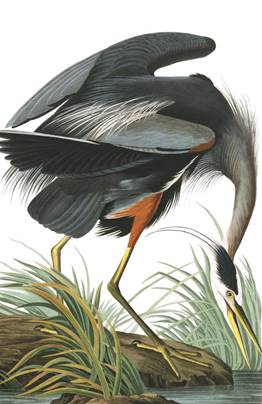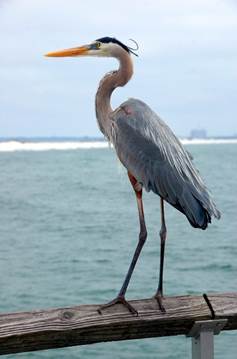
Out of their loneliness for each other two reeds, or maybe two shadows,
lurch forward and become suddenly a life lifted from dawn or the rain.
It is the wilderness come back again, a lagoon with our city reflected in its eye.We live by faith in such presences.
It is a test for us, that thin but real, undulating figure that promises,
“If you keep faith I will exist at the edge, where your vision joins the sunlight and the rain: heads in the light, feet that go down in the mud where the truth is.”—WILLIAM STAFFORD, 1987
Ardea – Latin for heron, herodias – Greek, heros – hero or fighter; oides – song; so song of the hero – though this is one interpretation and appears speculative.
If you are around the nests of these birds you will quickly get an example of their “hero song”. To me they sound like a pterodactyl – or what I imagine one would sound like anyway. Within walking distance of our Seattle office there is a nesting colony of GBHs along the south side of the Ballard Locks and they are quite vocal this year tending to their young. http://www.bing.com/videos/search?q=video+of+ballard+locks+herons&view=detail&mid=76EACA2B5DCE379777FD76EACA2B5DCE379777FD&FORM=VIRE
This is the largest heron in North America and worldwide is only surpassed in size by the goliath heron (good name!) and the white-bellied heron. The GBH is 36-54 inches long with a wingspan of up to 79 inches. It can stand as tall as 54 inches, which can be pretty intimidating with that long, sharp bill. Since they are very good hunters and you can watch them quickly snap up small fish, you can imagine what fast work they would make of your eyeball – so do not approach them. It has a range across North and Central America, the Caribbean and the Galapagos Islands. It occasionally is found in Spain, the Azores, England, and the Netherlands. GBHs have slatey blue flight feathers, reddish-brown thighs, a reddish-brown strip up the side, and a rusty colored neck. There is black and white streaking down the front with a mostly white face. Feathers on the neck are longer forming a plume.
BHs primarily eat fish but will prey upon shrimp, crabs, insects, rodents, small mammals, amphibians, reptiles and small birds. I’ve seen them eat rats, snakes, frogs, and a variety of fish. They will nest in colonies, putting together what appear to be quite flimsy nests of sticks in the upper reaches of trees. This heronry can range from a handful to up to 500 nests. Nests are generally 20 inches or so across and support a typical brood of 2-3. Eggs are laid in two-day intervals and incubated for about 27 days – hatching over a series of days. Incubation is shared between the parents. Both parents feed the young by regurgitating food – which means the parents consume about 4 times what they would eat without the youngsters present.
In turn, lots of predators take aim at herons during the nesting season. These include turkey vultures, ravens, crows, red-tailed hawks, great-horned owls, and bald and golden eagles. At this time of the year (May) you can see a good sized colony at the Nisqually National Wildlife Refuge here in WA. Along the north-facing bluff along McAllister Creek you also can watch the bald eagles occasionally drop by to pick off young herons like little tidbits of popcorn shrimp – if you enjoy such spectacles.
I worked for several years as a fisheries biologist back east on the Susquehanna River – them main tributary to Chesapeake Bay. We would see several species of herons quite often and one day while near the large Conowingo Dam we saw one flopping around in the middle of the river and not in the usual hunting areas on rocks in shallower, calm water.
It took us a bit to figure out that a fisherman on the catwalk of the dam had somehow hooked the bird and was now reeling him in so we went over to assist. I wish I had a pair of goggles with me as that bird with a snake -like neck and huge bill was not happy. After throwing a jacket over him and getting a good grip we extracted the hook form his wing and he set off. You don’t get to see these big birds so close and hold them – so despite the threat of becoming a pin cushion it was pretty cool.
And it is the “official bird” of the City of Portland, OR and in Seattle is the mascot of the Fremont Brewery http://www.fremontbrewing.com/
